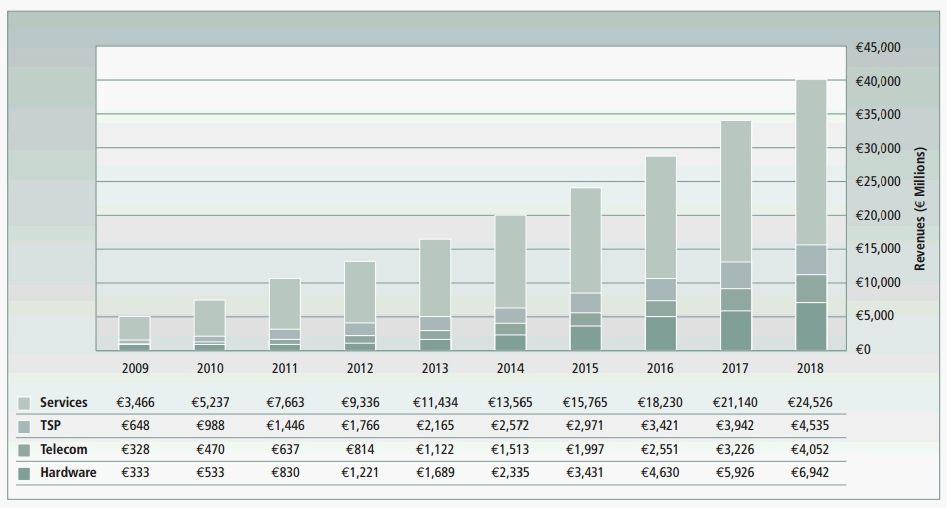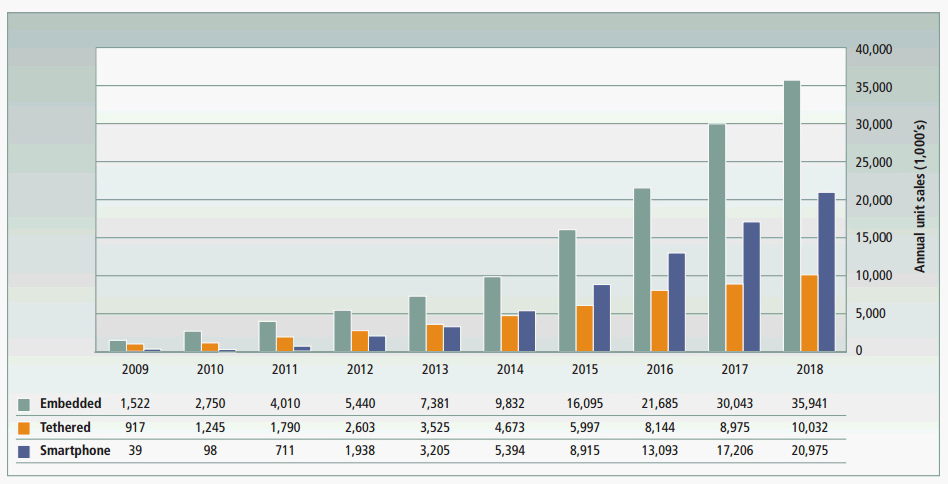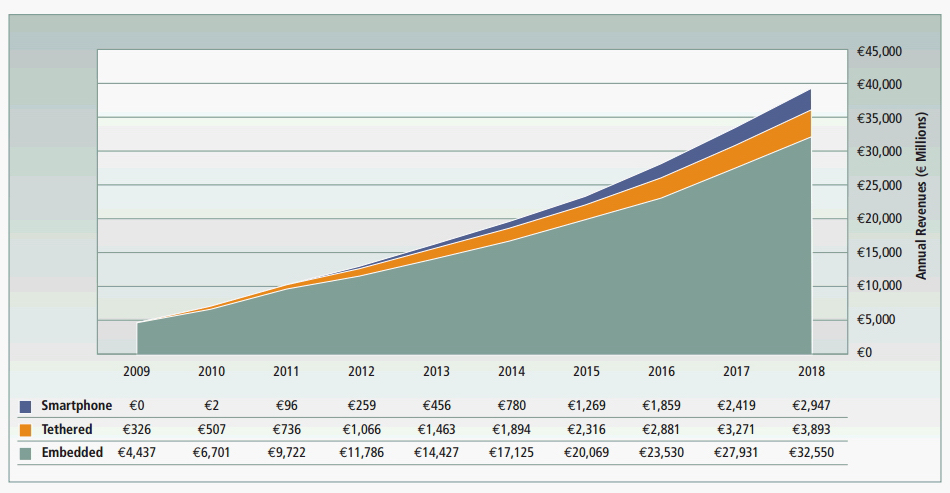Global Connected-car Market Poised for Three-fold Growth in 2018: SBD & GSMA
2013/08/30 | By Quincy LiangMobile telecom technology is advancing at unprecedented speed: now literally through its increasing integration in vehicles. The global connected-car market is estimated become a 39 billion euros industry in 2018, up from 13 billion euros in 2012, according to forecasts in a forecast report from research firm SBD and the GSMA, which represents the interests of mobile operators worldwide.
Over the next five years, the report indicates, there will be an almost seven-fold increase in the number of new cars equipped with factory-fitted mobile connectivity designed to meet demand among regulators and consumers for safety and security features, as well as infotainment and navigation services. The rapid development of the global connected-car market will be driven in part by positive regional regulatory action in Europe, Russia and Brazil.
Cross-Industry Cooperation
To enable the market to achieve its full potential, the automotive and mobile industries need to work closely together to deliver scalable, secure, interoperable, ubiquitous and intuitive connected experiences. For this reason, the GSMA says that it founded the Connected Car Forum (CCF) as a platform for sharing information between the automotive sector and mobile network operators. It is designed to enable joint cooperation and foster activities that may not be possible through existing bilateral business discussions in a timely manner.
The CCF is a response to the explicit need, expressed by both automakers and mobile operators, to remove current barriers and to improve the speed and take up of telematics and infotainment services.
To demonstrate their joint commitment towards achieving results, many CCF members are laying the groundwork for connected cars to become ubiquitous. According to the GSMA, the targets include:
■ More than 20% of vehicles sold worldwide in 2015 to include embedded connectivity solutions;
■ More than 50% of vehicles sold worldwide in 2015 to be connected (either by embedded, tethered or smartphone integration);
■ Every new car to be connected in multiple ways by 2025.

In revenue terms, SBD estimates the overall connected-car market will be three times larger in 2018 than it was in 2012, comprising:
■ 24.5 billion euros from in-vehicle services, such as traffic information, call center support and web-based entertainment (up from 9.3 billion euros in 2012);
■ 6.9 billion euros from the sale of hardware, such as telematics control units (up from 1.2 billion euros in 2012);
■ 4.5 billion euros from the delivery of telematics services, such as customer relationship management, (up from 1.8 euros billion in 2012);
■ 4.1 billion euros from the provision of connectivity, such as mobile data traffic (up from 814 million euros in 2012).
36 M. Embedded Telematics By 2018
Using a bottom-up methodology, SBD forecasts that almost 36 million new cars will be shipped globally with embedded telematics by 2018--31% of the total number of cars shipped in that year, compared to 5.4 million in 2012. An embedded solution is defined as a system, such as BMW ConnectedDrive and GM Onstar, in which both the connectivity and the intelligence are embedded into the car.

The growth in embedded connectivity is likely to be fuelled in part by regulations in the European Union (EU) and Russia making it mandatory for new vehicles to ship with systems able to automatically alert emergency services in the event of an accident. In this case, the advantage of an embedded system is that it will still work even if the driver's handset does not have residual battery or if it is not present in the car. Sales of cars with embedded connectivity should also be boosted by regulation in Brazil that require new vehicles to be equipped with stolen vehicle tracking systems that enable a car to be located remotely.
However, there is some uncertainty around the above-mentioned forecasts – regulatory mandates related to connected cars have already experienced significant delays, and may be delayed further due to political or technical difficulties.
Smartphones
SBD forecasts that almost 21 million of the cars sold in 2018 will be fitted with so-called smartphone integration systems (18% penetration). In 2012, 1.9 million cars shipped with smartphone integration solutions, such as Ford Applink or Toyota Entune, which rely on all or some of the intelligence being hosted on the owner's smartphone. These systems typically enable the driver or passengers to view apps running on the driver's smartphone on a screen in the car and, in some cases, to interact with these apps via controls in the vehicle. In 2013 SBD expects to see a much faster growth of standardized smartphone integration solutions, with approximately one million MirrorLink-enabled head-units being shipped globally.

SBD expects 10 million of the cars sold in 2018 to be fitted with tethered solutions (9% penetration), up from 2.6 million cars in 2012. These tethered systems, such as Mercedes Command, rely on intelligence embedded into the car, but use the owner's mobile phone for connectivity. In this case, apps run using the in-car computer, rather than a smartphone.
Although tethered systems will see steady growth, SBD believes they will be less popular with automakers than smartphone integration systems because of technical and policy hurdles related to connecting the handset with the in-car computer.
In revenue terms, embedded systems are likely to dominate the sector over the next five years. They will account for almost 83% of the revenues generated by connected cars in 2018, according to the new forecasts. Tethered systems are set to generate 10% of the revenues and smartphone integration systems the remaining 7%.
Safety and security applications, such as the eCall emergency-call systems that alert the emergency services in the event of an accident, will be the most common services supported by connected cars, shipping in 41.7 million vehicles in 2018, according to the forecasts, up from 7 million in 2012. In the EU, Russia and Brazil, the widespread deployment of these safety systems will depend on the implementation of the above-mentioned regulations.
Infotainment Services
Fuelled in part by growth in the deployment of smartphone integration systems, SBD predicts in-car infotainment services, such as news, weather, social networking and music streaming, will be very popular, supported by 32.1 million cars sold in 2018 compared with 4.3 million in 2012.
Growth in navigation services is set to be slightly slower, shipping in 28.5 million cars in 2018, compared with 5.12 million in 2012, according to the forecasts. SBD expects vehicle management applications, such as remote diagnostics and maintenance, to be supported by 14.8 million cars sold in 2018, compared with 5.5 million in 2012. SBD anticipates that these services, which rely on embedded systems, will not see the same level of demand from consumers as infotainment and navigation systems.
Built-in support for usage-based insurance programs, in which drivers pay according to how far they drive and their style of driving, will see more modest growth, according to the new forecasts.
SBD expects 4.3 million of the cars sold in 2018 to be fitted with these systems, compared with 2.9 million in 2012. This relatively slow growth reflects SBD's belief that most of these systems will be fitted after the car has been sold, rather than before the vehicle ships.
Electric vehicles typically ship with embedded systems both to alert the driver to nearby charging stations and to enable the manufacturer to monitor the performance of this new kind of car. The volume of connected electric vehicles shipped will rise from 260,000 in 2012 to 1.35 million in 2018, the study predicts.
On-going work
There is still significant uncertainty around automakers' telematics strategies in emerging markets, SBD says, such as China, and major new trends may emerge during the next three to five years.
Still, SBD and the GSMA are confident that the connected-car market is on the cusp of rapid growth.




